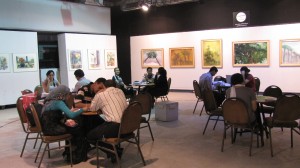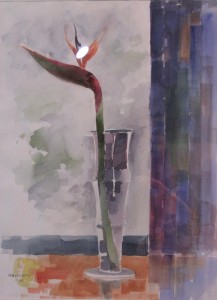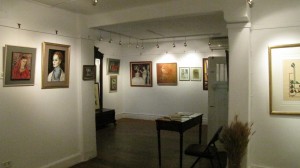Three New, Creative Spaces
All photos by the author

In my last column, I visited some of Cairo’s best-known, upscale galleries. This week, I’ll introduce to you three very different art spaces. First, I’ll visit El Sawy Culturewheel, one of my favorite places in Cairo. This non-profit organization gives artists a huge amount of freedom and lots of space to organize concerts, exhibitions, and even talks. Khan El Maghraby is another gallery that I recently discovered, and not only does it organize amazing exhibits, the people working there are truly remarkable. Finally, I’ll check out a new space that only opened a week ago, Arthropologie.
El Sawy Culturewheel
1 26 of July Street, Zamalek, Cairo
www.culturewheel.com

El Sawy Culturewheel (Sakkiat El Sawy in Arabic, commonly known as “El Sakkia”) was established in 2003 by engineer Mohamed El Sawy, in memory of his father (Abdel Moneim El Sawy, novelist and former Minister of Culture). It was the first privately owned, non-governmental cultural center in Egypt and is charmingly located under a bridge on the island of Zamalek, with spaces opening right on the Nile shore.
El Sakkia hosts poets, writers, singers, artists, musicians and most recently, politicians. The cultural center held a series of seminars in early March entitled “Egypt in Transition.” Political figures such as Nabil El Araby (the Foreign Minister at the time) as well as Tahani El Gebali, Deputy President of the Supreme Constitutional Court and political analyst Ammar Ali Hassan were present to discuss the basics of democracy and the concept of citizenship. Regular activities at the center include book fairs, music and film festivals, art exhibitions, workshops and seminars.

This space is special to me on a personal level. Last year, a friend of mine and I were looking for a gallery that would exhibit her autistic brother’s work. Most of the galleries we went to saw their role as a moneymaking business. El Sakkia, on the other hand, embraced us and his work. For almost nothing, they exhibited his work, printed out flyers and invitations and most of all, were very friendly. For that, I will forever be grateful to the center.
I went to El Sakkia on a Wednesday in the early afternoon. The place was full of young people. Some were there to attend discussions, and others were studying at the numerous libraries the organization offers; but the majority was sitting by the river, socializing.

The first place I went to was the so-called “Word Hall”. The space itself is quite simple, with white walls and black flooring. There were about 30 paintings on view by the emerging Egyptian artist called Magd El Din El Hossamy. Because the gallery itself is situated between two auditoriums, people constantly walk in and out of the exhibition space. The gallery attendant was standing next to a price list hung on the wall, but did not know anything regarding the artist. He was there in case anyone wanted to buy a painting, in which case he would give out the number of the artist or of his manager.

Most of the displayed works were watercolors, with a few oil paintings. The subject matter was nature and flowers. What attracted my attention were not the paintings, though. Instead, I was more interested in a couple of tables in the middle of the space, where young people were sitting, talking and studying.
In the adjacent auditorium, a poetry competition was in progress. The fusion of the artwork, the people studying, and the eloquent words being performed was uplifting and heartening. I was happy to see the center so active and the encouragement of Egyptians to develop their artistic talents.
To access El Sakkia’s open space on the Nile shore, where a music fair was taking place, I had to pay 5 EGP (Egyptian Pounds), equivalent to less than $1. The ticket enables you to spend two entire days by the Nile and looking at the instruments in the fair. A lot of people were present, eating, drinking and talking.
I hadn’t heard about this fair, called “Sound of Ray,” but it was nice to see that the center had organized it so well. There were a multitude of instruments, and professionals as well as amateurs were there testing them and playing some music. The same space also often holds concerts.

Khan El Maghraby
18 El Mansour Mohamed Street, Zamalek, Cairo

Later, I went to Khan El Maghraby — a small, but significant gallery. The space is located in a basement, and has two main rooms and a long corridor. I started taking pictures, and then the gallery attendant came to talk to me. I had one of the most interesting conversations of my time here with him.
The attendant, Shaker El Idrissy, has been working at the gallery for the last couple of years. He told me that the gallery organizes its exhibitions based on three characteristics. First, they exhibit the works of what he calls “big but unknown artists.” For example, they recently showed the works of Abdallah Gohar, a sculptor who passed away. He says his work is phenomenal, but he died without being acknowledged for its quality. The gallery also exhibits works by female artists under the age of 20. El Idrissy said that he noticed that there are a lot of girls in the art world, but they sometimes go unnoticed. Khan El Maghraby works with those who have never exhibited before, introduces them to each other and arranges discussions with them. Finally, the gallery works with completely unknown artists who can be “the stars of the future,” he says.
It is somehow ironic that these are the three characteristics that he defines the philosophy of the gallery with, when the current exhibition holds works by Salah Taher, Mohamed Abla, Bahgoury, Rabab El Nemr, and others. All of these names are significant in the art world in Egypt.

El Idrissy then asked me why I was taking pictures and taking so many notes. I explained that I was studying arts administration and policy at SAIC. He told me that he was doing his PhD in arts administration, and is writing his thesis on how to train curators to be more creative in Egypt. He illustrates his paper with an example from Cairo, which is relatively the most developed market in Egypt, and another from El Dakhla, a small governorate to the West of Egypt. I visited this place before. It is in the middle of the desert, with a few oases every here and there. He is working with artists in a small village called “Zakhira”. The art there is very traditional, different from what you would see in Cairo. El Idrissy also works at the Opera’s Palace of Arts, and his breadth of knowledge is impressive. I am reassured to find arts administrators in Egypt, thinking about the same issues as I am and being proactive about creating new opportunities for artists and art professionals.
Talking about the revolution, El Idrissy was proud to say that Khan El Maghraby was the first space to do an exhibit a couple of days after the president resigned. He said that artists were against the idea and the exhibit was somehow controversial. People believed the revolution was not over (on a side note, I still wonder today if it really is over). The exhibition, entitled “Egypt is Our Country,” was a tribute to Ahmed Bassiouny. Bassiouny was a renowned artist who was shot on January 28th, 2011, the bloodiest day of the revolution. His work is currently presented at the Venice Biennale. The Khan El Maghraby exhibition was a collection of works by different artists, many of them friends of Bassiouny. El Idrissy, who is an artist himself, showed me the paintings he did in homage to his friend and colleague.

El Idrissy also claims that the post-modernism movement in Egypt (a movement focused on sex, politics, and social issues such as poverty) has ended. He believes that there is a newly found freedom, and with it has come an optimism and a patriotism that was not there before. El Idrissy sees artists as communicating those new feelings, and ceasing to focus on the more negative aspects of the country. He is convinced that artists will start working with new media a lot more, now that it has played a crucial role in the past couple of months.
Before I walked out of the gallery, El Idrissy took my contact information. He wants me to send him information regarding galleries in Chicago; maybe he can compare them to galleries in Egypt, he said. I left feeling I just met my first Egyptian colleague.
Arthropologie
13a Marashly Street, Zamalek, Cairo
www.facebook.com/arthropologie

After visiting Khan al Maghraby, I stumbled upon another gallery right next to one of my favorite restaurants. Arthropologie is located on the ground floor of a building, with a couple of spaces in its basement. I stepped into the building to find the porter running behind me. He opened the door of what looked like an apartment and starting switching all of the lights on. There was no one in the gallery, except for the porter, my father and I.
The main space is interesting, with white walls and old hardwood floors. There were a good number of paintings and a couple of sculptures here and there. The porter told me that the opening was just a couple of days prior to my visit, and it was obvious. There were still balloons at the entrance.
The works were varied. The paintings on the wall opposite the entrance were by the renowned artist Mohamed Abla. The rest were by emerging artists. There were a couple of mixed media works, photographs and jewelry as well. I was disappointed by the lack of labels on most of the works. The labels that were in fact present only had the name of the artist (often misspelled). I also asked for a catalogue or an invitation, and the porter told me he didn’t have anything. I should check their Facebook page, he said.
This is the description I later found online: “Arthropologie is an art gallery dedicated to showcasing and promoting contemporary art from Egypt. Founded by young designers and art-lovers, the gallery will offer a full range of modern gallery services, from exhibitions, to art events, and is dedicated to the cultural enrichment of the Egyptian community.

Located in Cairo’s heart and its artistic inspiring zone, Zamalek, the gallery’s mission is to be a leader in the presentation and promotion of contemporary visual arts within the local, national and international audiences, as well as developing an understanding and appreciation of art’s complex role in reflecting and affecting how Egyptian people relate critically and creatively to a changing world.”
The variety of the works made for a lively exhibition, and although it was not an exhibition about the revolution, it was obvious that participating artists felt compelled to share post-revolutionary works.
This week’s gallery crawl made me optimistic regarding the future of my country. Egypt is witnessing a new era, and the art scene is developing fast. Everybody has something to express, something to share. People feel they can do anything, and they have started experimenting with new media. El Sakkia has been encouraging young Egyptians for the past couple of years, and even more so after the revolution. It also holds talks regarding social issues, and these days, its slogan is “no to corruption and bribes.” I found Khan El Maghraby’s philosophy regarding girls under 20 a great initiative to encourage artists from a young age, and the workshops they hold are a great way to discuss crucial issues in the art market. And I am always delighted when I hear about new galleries opening, like Arthropologie. Even though I believe they should have better renovated the basement area and put more effort towards the labels and didactic material, I still think it is a good incentive and a rather successful first show.

This week, stay tuned for an in-depth profile Townhouse, a space for independent art and a major player in the cultural landscape of the region; a survey of street art in Cairo; and reflections on the Egyptian Museum.








I am Lina one of the founders and owners of arthropologie gallery..i like your critisism and article a lot..i’m sad i was not there while your visit!!
All written about us is right and fair..i came right after you have gone..and the porter told me about your visit and i did not know that you were someone to write about the gallery..
the printings were finished in the opening sadly but they’re gonna be available soon before the existing exhibition is finished..
if you have any questions don’t hesitate..but the existing labels are not misspelled..i received them that way from the artists..
Thanks a lot,
Lina